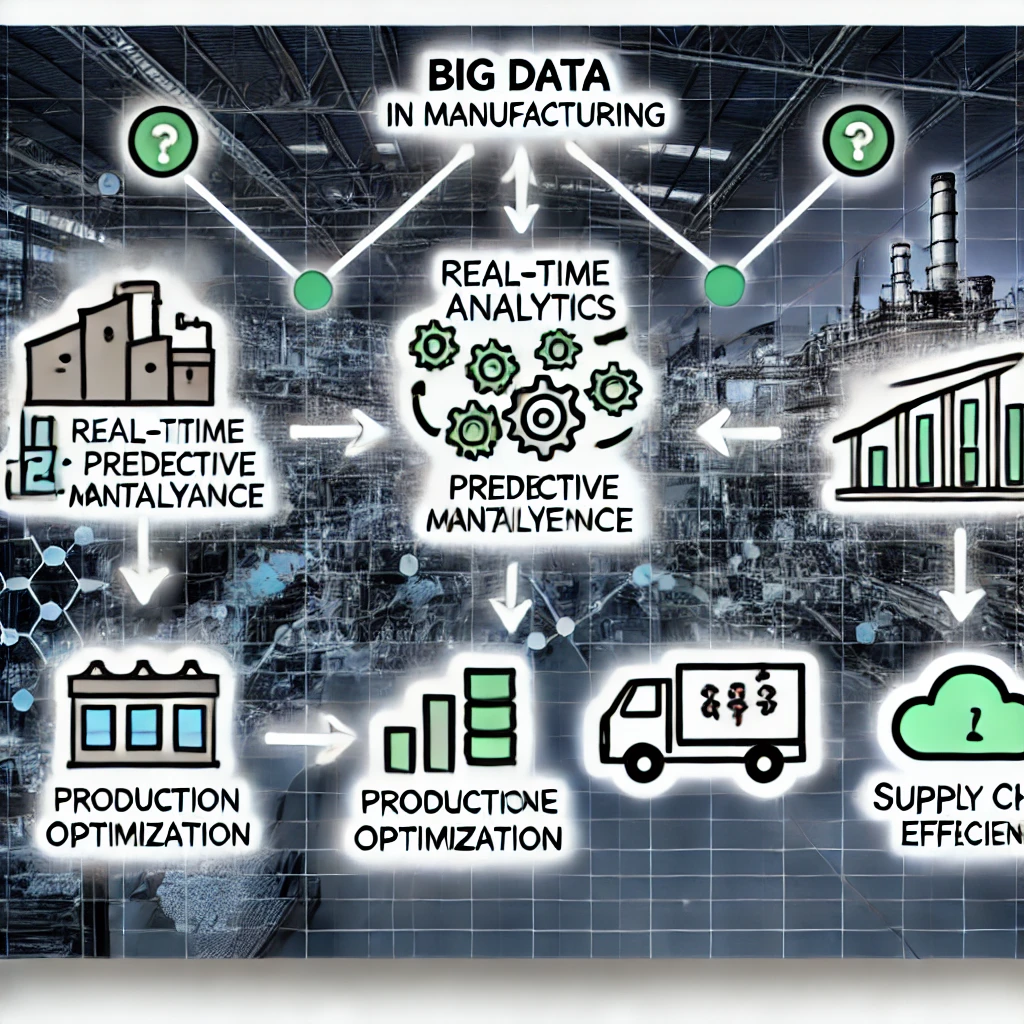The manufacturing industry is on the cusp of a significant transformation driven by the ever-growing importance of big data. Big data refers to massive datasets that contain detailed information about every aspect of a manufacturing operation.
With this data through advanced analytics, manufacturers gain unprecedented insights to optimize processes, improve quality control, and reduce costs.
Several factors drive this trend, including the increasing availability of sensors and other data-collection devices on factory floors. These devices generate a constant stream of data that can be used to track production lines, monitor equipment performance, and identify areas for improvement.
In addition, the rise of cloud computing has made it easier for manufacturers to store and analyze large datasets. Cloud-based platforms provide manufacturers the scalability and flexibility they need to handle the ever-increasing volume of data they generate.
Definition of Big Data
Big Data refers to the vast and complex datasets that are generated at high velocity from a wide array of sources. Unlike traditional data, Big Data is characterized by its sheer volume, variety, and speed at which it is collected.
In the manufacturing industry, Big Data includes everything from sensor readings on production lines to supply chain logistics, customer feedback, and beyond. What sets Big Data apart is its size and ability to process, analyze, and extract meaningful insights from it.
This data can be structured, like numerical metrics and timestamps, or unstructured, like social media posts and video footage. The true power of Big Data lies in turning this raw information into actionable intelligence that can drive decisions, optimize operations, and spur innovation within manufacturing processes.
Big data is a term used to describe datasets so vast and complex that traditional data processing applications struggle to handle them. These datasets are characterized by their volume, velocity, and variety.
- Volume: This refers to the sheer amount of data generated. This could include data from sensors, machines, supply chains, and customer interactions in manufacturing.
- Velocity: This highlights the speed at which data is generated and processed. For instance, real-time data from production lines requires rapid analysis to inform immediate decisions.
- Variety: This encompasses a diverse range of data types, including structured (numbers and text in databases), unstructured (text documents, images, audio, video), and semi-structured (emails, web pages).
The Role of Big Data Analytics in Manufacturing
The manufacturing industry has always been data-intensive, but the advent of Big Data has transformed how this data is utilized.
With the help of Big Data, manufacturers can achieve new levels of operational efficiency and foster innovation, often facilitated by data engineering services that ensure the seamless integration and processing of large datasets.
Moreover, the role of Big Data analytics in manufacturing extends across the entire production process, from the shop floor to the supply chain, and even into customer relations, enabling manufacturers to make informed decisions that drive success.
Data Sources in Manufacturing
Manufacturers generate vast amounts of data daily, and harnessing this data effectively is critical to driving operational excellence. Here’s a closer look at some of the primary sources of data within the manufacturing sector:
- Sensors and IoT devices: Modern manufacturing facilities are increasingly equipped with sensors embedded in machinery, equipment, and products. These devices collect real-time data on temperature, pressure, vibration, and other critical parameters.
- Production machinery and equipment: Information about machine performance, downtime, and maintenance schedules is essential for optimizing production processes and preventing equipment failures.
- Supply chain data: Data related to inventory levels, supplier performance, and logistics operations provides insights into supply chain efficiency and potential disruptions.
- Customer feedback and market trends: Understanding customer preferences and market dynamics is crucial for product development, marketing, and sales strategies.
Types of Data Collected
When both structured and unstructured data are integrated, manufacturers can achieve a more comprehensive understanding of their operations and market conditions, leading to better-informed strategies and innovations.
The data generated within a manufacturing environment can be categorized into two primary types:
1. Structured data
The term “structured data” is an information that has been prearranged and is frequently kept in databases or spreadsheets, which facilitates easy searching and analysis.This data type follows a specific format consisting of numerical values, dates, and times. For example:
- Production Quantities: Data on the number of units produced, defects, and output rates.
- Machine Speeds: Information on the operational speed of machinery, which can be crucial for monitoring efficiency and performance.
- Dates and Times: Timestamps related to production cycles, maintenance schedules, and supply chain events.
2. Unstructured data
Unstructured data, in contrast, has a different format or data model, making it more complex to process and analyze. Unstructured data, while more challenging to manage, is invaluable for providing deeper insights into areas that structured data alone may not cover.
This type of data is typically text-heavy and comes from a variety of sources, including:
- Customer Reviews are feedback left by customers on products, often found on e-commerce platforms or review sites. This data can offer insights into product performance, quality, and customer satisfaction.
- Social Media Posts: Information consumers and industry experts share on platforms like Twitter, LinkedIn, and Facebook. These posts can provide real-time insights into market trends, brand perception, and customer sentiment.
- Images and Video Recordings: Visual data collected from production lines, quality inspections, and security systems. Analyzing this data can help identify defects, monitor safety compliance, and improve quality control.
Applications of Big Data in Manufacturing
Big Data is revolutionizing the manufacturing industry by providing powerful tools and insights that drive efficiency, innovation, and competitiveness. Similar approaches are visible in energy and oil sectors, where digital oilfield solutions leverage advanced analytics to optimize operations, reduce downtime, and improve asset performance—showing how data-driven methods are transforming traditional industries.
Here are some of the critical applications of advanced analytics in the manufacturing industry:
Predictive Maintenance
When manufacturers continuously monitor equipment health through sensors and data analytics, they can predict potential failures before they occur. This proactive approach significantly reduces unplanned downtime, minimizes repair costs, and extends machinery’s lifespan.
Quality Control and Assurance
Big data empowers manufacturers to analyze vast production data to identify trends, anomalies, and defects. This enables real-time quality control, ensuring product consistency and adherence to stringent quality standards.
Supply Chain Optimization
With the help of big data, manufacturers can optimize their supply chains by enhancing inventory management, predicting demand fluctuations, and improving logistics and distribution. This leads to reduced stockouts, minimized carrying costs, and faster delivery times.
Production Process Optimization
Real-time analysis of production data provides valuable insights into identifying bottlenecks, inefficiencies, and areas for improvement. When optimized production processes are used, manufacturers can reduce waste, enhance throughput, and increase overall productivity.
Customer Insights and Product Development
Analyzing customer data, including purchasing behavior, preferences, and feedback, helps manufacturers understand customer needs and market trends.
These insights drive product innovation, customization, and development, ensuring products align with customer expectations and market demands.
Benefits of Big Data in Manufacturing
The manufacturing industry is undergoing a profound transformation driven by the power of big data. This vast and complex dataset revolutionizes operations from the factory floor to the executive suite. Let’s explore how big data is reshaping the manufacturing landscape.

Increased Efficiency and Productivity
Big data empowers manufacturers to optimize operations, make faster data-driven decisions, and streamline processes, increasing efficiency and productivity.
Cost Reduction
Manufacturers can significantly reduce production costs by minimizing waste, optimizing energy consumption, and predicting equipment failures.
Improved Product Quality
Big data analytics enable rigorous quality control, ensuring products meet stringent standards and reducing defects, leading to higher product quality.
Enhanced Innovation
The wealth of data available through big data accelerates research and development processes, fostering innovation and the creation of new products tailored to market demands.
How Big Data Can Improve Manufacturing Industry
Data engineering is the backbone of any successful significant data initiative. It involves the entire lifecycle of data, from collection to analysis.

Data Collection and Ingestion
The first step in harnessing the power of big data is to effectively collect data from various sources, including sensors, machines, ERP systems, and external databases, often facilitated by advanced big data platforms that streamline the collection and ingestion processes. Data accuracy, reliability, and consistency are crucial for deriving meaningful insights.
Data Storage Solutions
Storing massive amounts of data requires solutions. Manufacturing organizations often utilize a combination of databases, data lakes, and cloud storage platforms to accommodate diverse data types and volumes.
Scalability and performance are critical factors to consider when selecting storage solutions. For example, a Snowflake Consultant can help in optimizing cloud storage solutions to handle the massive scale and variety of Big Data.
Data Processing and Transformation
Raw data is often unstructured and requires cleaning, transformation, and enrichment before analysis. This involves handling missing values, outliers, and inconsistencies. Data processing can be performed in real-time for immediate insights or in batches for historical analysis, should align with a comprehensive data warehouse strategy to ensure that the processed data is efficiently stored and readily accessible for further analytics.
Data Integration
Combining data from disparate sources is essential for creating a comprehensive view of operations. Data integration involves aligning data structures, resolving inconsistencies, and establishing relationships between different datasets.
Implementing a strong data migration strategy is critical during this process to ensure that data from older systems or different platforms is seamlessly integrated without loss or corruption, maintaining the accuracy and reliability of the combined datasets.
Data Analytics and Visualization
Once data is cleaned, integrated, and transformed, it’s ready for analysis. This is where the importance of data analytics strategy becomes evident, as it guides the use of various tools like SQL, Python, and R to extract valuable insights that drive business decisions. Data visualization techniques are used to communicate findings and create interactive dashboards and reports effectively.
Challenges of Implementing Big Data in Manufacturing
While the potential benefits of big data for manufacturing are substantial, its implementation is challenging.
Data Management and Integration
One of the primary hurdles in significant data initiatives is managing and integrating vast volumes of data generated from diverse sources. This includes data from sensors, machines, ERP systems, and external partners.
This is where data strategy consulting becomes invaluable, as it helps manufacturers design and implement effective strategies to ensure data consistency, quality, and accessibility, overcoming common challenges and driving successful outcomes. Ensuring data consistency, quality, and accessibility is crucial for accurate analysis.
Security and Privacy Concerns
The sensitive nature of manufacturing data, including intellectual property, customer information, and operational details, necessitates robust security measures. Protecting this data from cyber threats while adhering to industry regulations is paramount.
Skilled Workforce
Successful implementation of big data projects requires a skilled workforce with data science, analytics, and engineering expertise. Acquiring and retaining these talents can be challenging, especially in industries where these roles are relatively new. Upgrading the skills of existing employees to handle data-driven tasks is also essential.
Initial Investment
Implementing an extensive data infrastructure involves significant upfront hardware, software, and personnel costs. Justifying this investment to stakeholders can be difficult, as determining the return on investment may take time. Demonstrating the potential long-term benefits and aligning the project with overall business objectives is crucial.
Future Trends in Big Data and Manufacturing
The intersection of big data and manufacturing is a dynamic field, constantly evolving with technological advancements. Several emerging trends can potentially reshape the industry in the coming years.
The convergence of these below trends will create new possibilities for manufacturers, enabling them to achieve greater efficiency, flexibility, and sustainability.
Artificial Intelligence and Machine Learning
Artificial intelligence (AI) and machine learning (ML) rapidly transform manufacturing operations. Advancements in predictive analytics enable manufacturers to forecast equipment failures, optimize inventory levels, and predict market demand with unprecedented accuracy.
Moreover, the integration of AI is driving the development of autonomous systems and robotics, which are capable of performing complex tasks with minimal human intervention.
Edge Computing
Edge computing brings data processing closer to the source, reducing latency and improving real-time decision-making.
In manufacturing, this trend is crucial for applications like quality control, predictive maintenance, and autonomous systems. Manufacturers can respond swiftly to changing conditions and optimize operations by processing data at the edge.
Digital Twins
Digital twins are virtual replicas of physical assets, allowing manufacturers to simulate and test various scenarios without affecting real-world operations.
This technology optimizes production processes, product design, and maintenance schedules. Companies can reduce costs, improve product quality, and accelerate time-to-market by using digital twins.
Sustainable Manufacturing
Big data plays a vital role in driving sustainability initiatives. Manufacturers can identify opportunities to reduce environmental impact by analyzing energy consumption patterns, material usage, and waste generation. Data-driven insights can optimize resource utilization, minimize emissions, and develop eco-friendly products and processes.
FAQs
How is big data used in the manufacturing industry?
Big Data in manufacturing optimizes production, predicts equipment failures, enhances quality control, and streamlines supply chains, leading to increased efficiency, reduced costs, and improved product consistency.
How is Coca-Cola using big data?
Coca-Cola uses Big Data to personalize marketing campaigns, optimize supply chains, and improve product development by analyzing consumer preferences, purchasing behaviors, and real-time sales data across various markets.
How does Nestlé use big data?
Nestlé leverages Big Data to enhance product innovation, optimize supply chains, and improve customer engagement by analyzing consumer behavior, market trends, and operational efficiency across its global operations.
Conclusion
Big Data fundamentally transforms the manufacturing industry by enabling enhanced efficiency, predictive maintenance, and more intelligent decision-making.
However, the journey from data to insight can be complex. That’s where Folio3 Data services come in—they don’t just provide solutions; they work closely with manufacturers to tailor strategies that turn raw data into actionable insights.
As manufacturers continue to make the most of this vast resource, they will achieve new opportunities for innovation, cost reduction, and customer satisfaction, ensuring they remain competitive in an increasingly data-driven world.





